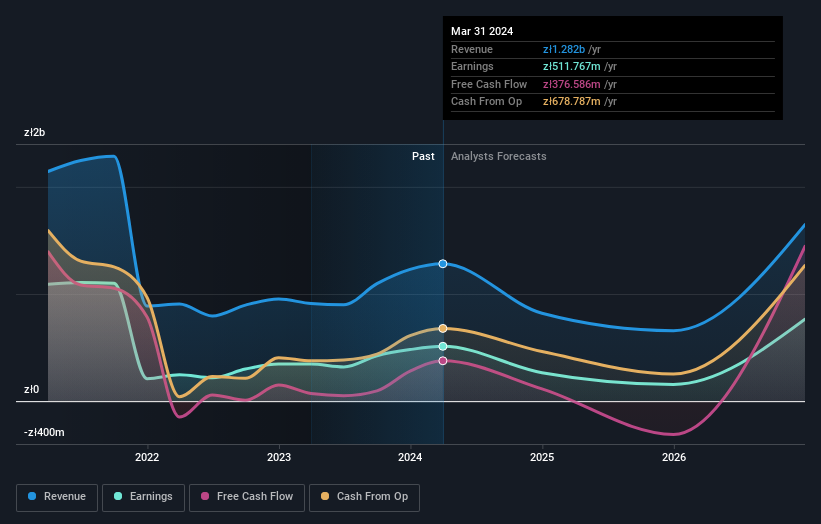- Poland
- /
- Entertainment
- /
- WSE:CDR
CD Projekt S.A. (WSE:CDR) surges 8.3%; retail investors who own 42% shares profited along with insiders

Key Insights
- Significant control over CD Projekt by retail investors implies that the general public has more power to influence management and governance-related decisions
- 51% of the business is held by the top 10 shareholders
- Insider ownership in CD Projekt is 35%
If you want to know who really controls CD Projekt S.A. (WSE:CDR), then you'll have to look at the makeup of its share registry. We can see that retail investors own the lion's share in the company with 42% ownership. In other words, the group stands to gain the most (or lose the most) from their investment into the company.
Following a 8.3% increase in the stock price last week, retail investors profited the most, but insiders who own 35% stock also stood to gain from the increase.
Let's take a closer look to see what the different types of shareholders can tell us about CD Projekt.
Check out our latest analysis for CD Projekt

What Does The Institutional Ownership Tell Us About CD Projekt?
Institutional investors commonly compare their own returns to the returns of a commonly followed index. So they generally do consider buying larger companies that are included in the relevant benchmark index.
We can see that CD Projekt does have institutional investors; and they hold a good portion of the company's stock. This implies the analysts working for those institutions have looked at the stock and they like it. But just like anyone else, they could be wrong. It is not uncommon to see a big share price drop if two large institutional investors try to sell out of a stock at the same time. So it is worth checking the past earnings trajectory of CD Projekt, (below). Of course, keep in mind that there are other factors to consider, too.

Hedge funds don't have many shares in CD Projekt. Because actions speak louder than words, we consider it a good sign when insiders own a significant stake in a company. In CD Projekt's case, its Top Key Executive, Marcin Iwinski, is the largest shareholder, holding 13% of shares outstanding. With 10.0% and 6.9% of the shares outstanding respectively, Michal Kicinski and Piotr Nielubowicz are the second and third largest shareholders. Additionally, the company's CEO Adam Badowski directly holds 0.7% of the total shares outstanding.
We also observed that the top 10 shareholders account for more than half of the share register, with a few smaller shareholders to balance the interests of the larger ones to a certain extent.
While studying institutional ownership for a company can add value to your research, it is also a good practice to research analyst recommendations to get a deeper understand of a stock's expected performance. There are a reasonable number of analysts covering the stock, so it might be useful to find out their aggregate view on the future.
Insider Ownership Of CD Projekt
The definition of company insiders can be subjective and does vary between jurisdictions. Our data reflects individual insiders, capturing board members at the very least. Management ultimately answers to the board. However, it is not uncommon for managers to be executive board members, especially if they are a founder or the CEO.
Most consider insider ownership a positive because it can indicate the board is well aligned with other shareholders. However, on some occasions too much power is concentrated within this group.
It seems insiders own a significant proportion of CD Projekt S.A.. It has a market capitalization of just zł16b, and insiders have zł5.8b worth of shares in their own names. That's quite significant. It is good to see this level of investment. You can check here to see if those insiders have been buying recently.
General Public Ownership
The general public-- including retail investors -- own 42% stake in the company, and hence can't easily be ignored. While this size of ownership may not be enough to sway a policy decision in their favour, they can still make a collective impact on company policies.
Next Steps:
I find it very interesting to look at who exactly owns a company. But to truly gain insight, we need to consider other information, too.
I always like to check for a history of revenue growth. You can too, by accessing this free chart of historic revenue and earnings in this detailed graph.
If you would prefer discover what analysts are predicting in terms of future growth, do not miss this free report on analyst forecasts.
NB: Figures in this article are calculated using data from the last twelve months, which refer to the 12-month period ending on the last date of the month the financial statement is dated. This may not be consistent with full year annual report figures.
New: AI Stock Screener & Alerts
Our new AI Stock Screener scans the market every day to uncover opportunities.
• Dividend Powerhouses (3%+ Yield)
• Undervalued Small Caps with Insider Buying
• High growth Tech and AI Companies
Or build your own from over 50 metrics.
Have feedback on this article? Concerned about the content? Get in touch with us directly. Alternatively, email editorial-team (at) simplywallst.com.
This article by Simply Wall St is general in nature. We provide commentary based on historical data and analyst forecasts only using an unbiased methodology and our articles are not intended to be financial advice. It does not constitute a recommendation to buy or sell any stock, and does not take account of your objectives, or your financial situation. We aim to bring you long-term focused analysis driven by fundamental data. Note that our analysis may not factor in the latest price-sensitive company announcements or qualitative material. Simply Wall St has no position in any stocks mentioned.
About WSE:CDR
CD Projekt
Together its subsidiaries, engages in the development, publishing, and digital distribution of video games for personal computers and video game consoles in Poland.
Outstanding track record with flawless balance sheet.


